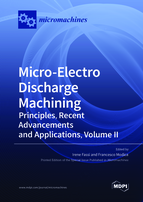Micro-Electro Discharge Machining: Principles, Recent Advancements and Applications, Volume II
A special issue of Micromachines (ISSN 2072-666X). This special issue belongs to the section "D:Materials and Processing".
Deadline for manuscript submissions: closed (10 April 2022) | Viewed by 19363
Special Issue Editors
Interests: micro manufacturing; micro robotics; micro assembly; micro EDM; micro injection molding
Special Issues, Collections and Topics in MDPI journals
Interests: micro EDM; micro manufacturing; additive manufacturing; virtual prototyping
Special Issues, Collections and Topics in MDPI journals
Special Issue Information
Dear Colleagues,
Micro Electrical Discharge Machining (micro-EDM) is a thermo-electric and contactless process most suited for micro-manufacturing and high-precision machining, especially when difficult-to-cut materials, such as super alloys, composites, and electro conductive ceramics, are processed. Among the various micro-machining processes, micro-EDM is known to have many industrial applications, such as high-aspect-ratio micro holes for fuel injectors, high-precision moulds, and biomedical components. The main issues restricting the application of micro-EDM involve handling and fixturing, electrode and workpiece preparation, process parameter optimization, the identification and minimization of source of errors as tool wear, and measurement issues.
In the recent past, numerous EDM systems have been developed for performing micro- and nano-scale EDM. These systems use newer control strategies and optimization methodologies to perform the EDM processes.
This Special Issue pursues contributions (research papers, short communications, and review articles) that focus on recent developments in micro-EDM machining. Topics of interest include but are not limited to the following:
- Process mechanism modeling and simulation;
- Process monitoring and control;
- Parameters optimization;
- Tool wear management;
- Novel machine concept;
- New material processing;
- Dielectrics;
- High-aspect-ratio features and surface texturing;
- Hybrid machining;
- New application of micro-EDM process.
We look forward to receiving your submissions.
Dr. Irene Fassi
Dr. Francesco Modica
Guest Editors
Manuscript Submission Information
Manuscripts should be submitted online at www.mdpi.com by registering and logging in to this website. Once you are registered, click here to go to the submission form. Manuscripts can be submitted until the deadline. All submissions that pass pre-check are peer-reviewed. Accepted papers will be published continuously in the journal (as soon as accepted) and will be listed together on the special issue website. Research articles, review articles as well as short communications are invited. For planned papers, a title and short abstract (about 100 words) can be sent to the Editorial Office for announcement on this website.
Submitted manuscripts should not have been published previously, nor be under consideration for publication elsewhere (except conference proceedings papers). All manuscripts are thoroughly refereed through a single-blind peer-review process. A guide for authors and other relevant information for submission of manuscripts is available on the Instructions for Authors page. Micromachines is an international peer-reviewed open access monthly journal published by MDPI.
Please visit the Instructions for Authors page before submitting a manuscript. The Article Processing Charge (APC) for publication in this open access journal is 2600 CHF (Swiss Francs). Submitted papers should be well formatted and use good English. Authors may use MDPI's English editing service prior to publication or during author revisions.
Keywords
- Micro EDM
- Parameters optimization
- Process simulation
- Tool wear
- Difficult-to-cut material







